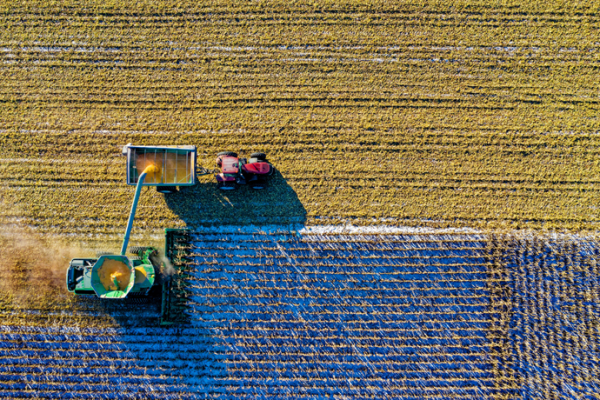GUEST CONTENT
The Canadian countryside conjures up images of both vast wilderness and plaid-clan farmers in bright red tractors. The first is a symbol of conservation and nature; the second a symbol of economy and production. ALUS is blurring those lines to bring us an innovative approach to nature-based solutions. Its New Acre Project helps corporations exceed sustainability objectives by supporting farmers and ranchers to build nature on their land one acre at a time. Bryan Gilvesy, Chief Executive Officer, ALUS, joined Not Your Grandpa’s Farm: Welcome to the NEW Bioeconomy at GLOBE Capital to discuss the financial, environmental, and social opportunities of a bioeconomy. We caught up with Mr. Gilvesy to learn about the great potential for ecosystem services through agriculture.
Was there a Eureka moment for you in terms of understanding the role for agriculture in fighting climate change?
Yes, there was. I was the third participant farmer to enroll in the ALUS program in 2006. The project that intrigued me at the time was the restoration of the native tall grass prairie here on my ranch in Norfolk County, Ontario. As I learned more about the grass, I realized it had extraordinarily long roots—12-16 feet—with a root ball that replenished itself every two years making it highly effective at sequestering carbon into the soil.
And then, because of the technical support offered by ALUS, my learning only grew. I realized that the grass prairie supports a whole suite of grassland birds like the meadow lark, and it was an important habitat for endangered species, like the American badger. My land became home to a whole suite of native pollinators that I didn’t even know existed. On top of that, those deep roots meant these grasses were extremely drought tolerant and could form part of my drought season feed for my cattle.
This was an ‘aha’ moment for me. I realized how effective native ecotypes can be at sequestering carbon and supporting biodiversity.
What makes an ALUS farmer different from the farmer down the road?
ALUS farmers come to view their farm as multifunctional. They don’t just see it as a means of producing food and fibre, but they also see that they can build natural capital, sequester carbon, increase biodiversity, foster climate resilience, and support wetlands and water. We’re all beginning to recognize that these things have value in the marketplace. ALUS farmers have come to the realization that their farm can be productive beyond the one thing they’ve typically been paid to produce.
What are some common misconceptions about farmers and ranchers and climate change?
Traditionally, we haven’t seen farmers as solution providers for climate change, but I think that notion is disappearing.
One misconception that’s still common is: we often interpret climate action as only the reduction of greenhouse gas emissions. It’s so much more than that. When farmers take climate action through nature, it creates a tremendous amount of leverage. You get a whole suite of co-benefits for biodiversity, resilience, water filtration, and more. Further, sequestering carbon effectively means improving soil, which makes our food stores more resilient as well.
ALUS’ New Acre Project captures the full suite of benefits that come from climate action on a farm and makes those benefits available through a marketplace.
Nature-based solutions have exploded in popularity in recent years. For professionals who are new to this space, where do you recommend they start?
I think they should start at the beginning by understanding how native plants function. Plants are part of the carbon cycle. They are energized by the sun and by breathing in carbon dioxide, which they then deposit into the soil through their roots. To reduce greenhouse gas emissions, we need more of this carbon cycle in the world. Native plants established in the correct locations using the correct ecotypes provide the ideal solution. These native plants don’t just absorb carbon, but they also serve as habitat for pollinators, water filtration devices, and habitat for endangered species. With all of this in mind, the advantages of nature-based solutions over mechanical solutions for carbon capture become more obvious.
Could you tell me more about your recent announcement with A&W Canada and Cargill and how it will help us achieve a net-zero future?
Sure. We’re really pleased that A&W Canada and Cargill have collaborated with us to create the Grazing Forward program, which is an extension of the New Acre Project at ALUS. This program will accelerate and enhance rancher-led grazing projects that mitigate climate change. A&W Canada and Cargill have generously committed $1.8 million over three years to support ranchers in Alberta, Saskatchewan, and Manitoba as they continue to scale regenerative agriculture practices. The program is expected to sequester up to 12,578 MT greenhouse gas emissions per year, equivalent to more than 50 million kilometres driven by the average passenger vehicle. ALUS will take a hands-on, local approach, working with interested Canadian beef ranchers to plan and implement practices that contribute to environmental outcomes. This effort will impact more than 6,000 acres and engage ranchers in 20 communities, extending the New Acre Project’s current reach by 233%. Needless to say, we’re very excited about it!
What was your biggest takeaway from GLOBE Capital?
Well, it was a pleasant experience for us, because our session included a poll asking attendees for their opinion on the greatest opportunity in the bioeconomy. Obviously, we thought emission reductions would be number one, but biodiversity rose to the top as a very important issue for the attendees, which is mostly a business audience. I would not have that expected that. It’s a pleasant surprise for us, because we believe biodiversity is the apex indicator of environmental health, and economic prosperity. If biodiversity shows up, we’ve put the right plants in the right places and managed them correctly. Biodiversity is a sign of a more resilient climate.




